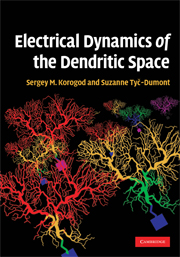Book contents
- Frontmatter
- Contents
- Preface
- 1 Definition of the neuron
- 2 3D geometry of dendritic arborizations
- 3 Basics in bioelectricity
- 4 Cable theory and dendrites
- 5 Voltage transfer over dendrites
- 6 Current transfer over dendrites
- 7 Electrical structure of an artificial dendritic path
- 8 Electrical structure of a bifurcation
- 9 Geography of the dendritic space
- 10 Electrical structures of biological dendrites
- 11 Electrical structure of the whole arborization
- 12 Electrical structures in 3D dendritic space
- 13 Dendritic space as a coder of the temporal output patterns
- 14 Concluding remarks
- Index
- References
10 - Electrical structures of biological dendrites
Published online by Cambridge University Press: 03 May 2010
- Frontmatter
- Contents
- Preface
- 1 Definition of the neuron
- 2 3D geometry of dendritic arborizations
- 3 Basics in bioelectricity
- 4 Cable theory and dendrites
- 5 Voltage transfer over dendrites
- 6 Current transfer over dendrites
- 7 Electrical structure of an artificial dendritic path
- 8 Electrical structure of a bifurcation
- 9 Geography of the dendritic space
- 10 Electrical structures of biological dendrites
- 11 Electrical structure of the whole arborization
- 12 Electrical structures in 3D dendritic space
- 13 Dendritic space as a coder of the temporal output patterns
- 14 Concluding remarks
- Index
- References
Summary
Any live dendrite contains constitutive parts, such as the artificial elements used in Chapters 7 and 8 to demonstrate the biophysical laws that rule the proximal-todistal and path-to-path electrical relationships. In fact, the live dendrite is made of similar elements and is ruled by the same laws. However, any piece of dendrite observed under a microscope in an histological preparation displays a much more complex shape than artificial elements. It appears tortuous, irregular, often nodular with branching points and daughter branches of different lengths and diameters. These idiosyncratic attributes are totally unpredictable, making dendrites unique.
In this chapter, as we tackle much more complex live objects, we consider first natural dendritic structures of moderate complexity: individual dendrites extracted from a whole arborization. We study electrical structures of natural dendrites in the same way as we did in the previous chapters dealing with simplified artificially built structures. We look for geometry-related features in the electrical structures in relation to structural heterogeneities and branchings in their natural occurrence. As the recognizable geometry-related features of electric structures are found for individual dendrites, they will be used as navigation tools in electrical structures of complex arborizations of different neuron types described in Chapter 11.
Geometry of an example dendrite
Here we show an example of a systematic study performed on one individual dendrite extracted from the reconstructed arborization of an abducens motoneuron of the rat (cell M5 in Figure 9.5). The location of the selected dendrite in the 3D space surrounding the soma is shown in Figure 10.1, A (Korogod et al., 1998).
- Type
- Chapter
- Information
- Electrical Dynamics of the Dendritic Space , pp. 127 - 140Publisher: Cambridge University PressPrint publication year: 2009



